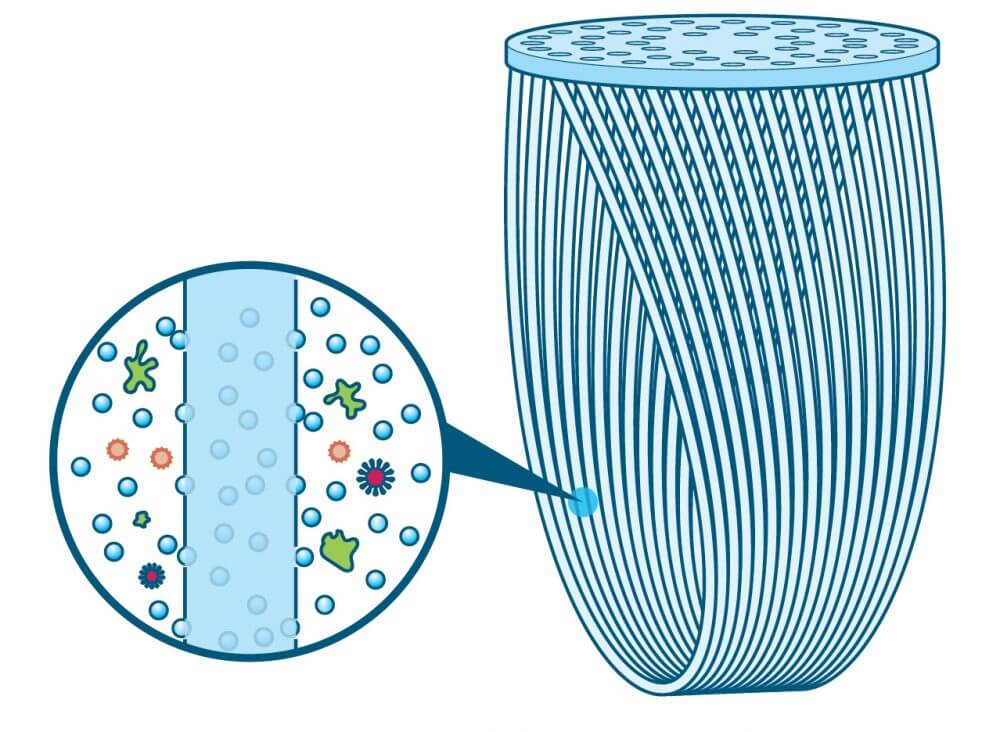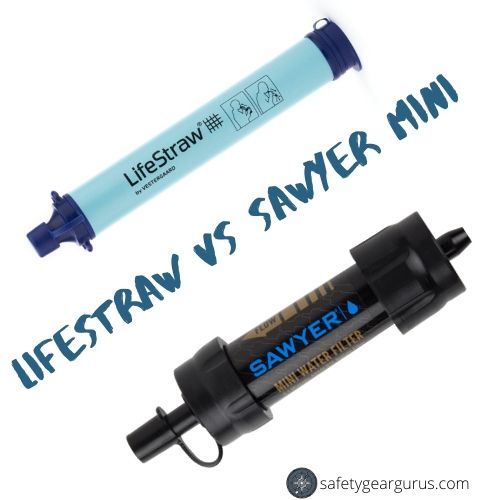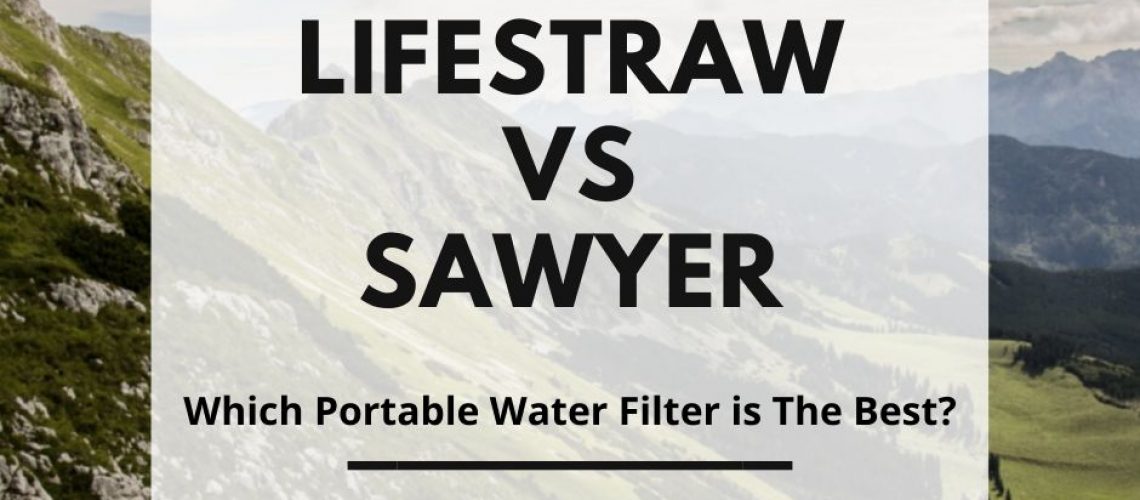Portable water filters are the new go to for emergency water filtration. With inventions such as the LifeStraw and LifeStraw Go water bottle with filter, along with the Sawyer Mini and Sawyer Squeeze water filtration system, bacteria filled, contaminated water that would once make you sick is now safe to drink.
We compare the LifeStraw and Sawyer Mini water filters so you can choose the best water filter for your needs.
At a glance: A quick comparison table of the LifeStraw vs Sawyer Mini
| LifeStraw | Sawyer Mini | |
| Size | 8.7” x 1” x 1” | 5” x 1” |
| Weight | 2.08 ounces | 1.6 ounces |
| Filter Microns | 0.2 microns | 0.1 microns |
| Filter Capacity | 1000 gallons | 100,000 gallons |
If you were looking for a quick comparison between the LifeStraw and Sawyer Mini and were wondering which one you should buy – the Sawyer Mini seems like the obvious choice.
The Sawyer Mini is smaller, lighter, has a tighter micron filter (for better filtration) and filters 100 times more than the LifeStraw. It is also multipurpose – can be used on water bottles, gravity packs and backpacks.
Both the LifeStraw and the Sawyer Mini Filter meet the United States Environmental Protection Agency drinking water standards for bacteria and protozoa reduction. Both products reduce bacteria in the water by the same amount and thus, create the same result.
For a more detailed comparison and review of the LifeStraw and Sawyer Mini water filters, keep reading.
Sawyer Mini Water Filtration System
One of the reasons we love the Sawyer Mini Water Filter so much is its versatility. Unlike the LifeStraw, you don’t need to get down close to the water to be able to drink it.
The end of the mini water filter can screw onto a regular water bottle, fit onto a pouch (included with the filter), attach to a hanging gravity bag for bulk water filtration, or onto your hydration backpack for inline water filtration.
Does the Sawyer Mini filter Bacteria?
Yes. The Sawyer mini water filter is certified for 0.1 micron filtration. This means that the pore size of the filter is 0.1 microns or less.
Harmful bacteria such as salmonella, protozoa, E. coli are larger in size that 0.1 microns, meaning they cannot pass through the filter. Water molecules are smaller than 0.1 microns, so water will pass through the filter only.

According to Sawyer, the complete list of bacteria filtered is: Bacteria, Protozoa, E. Coli, Giardia, Vibrio cholerea, Salmonella Typhi, Leptospirosis, and microplastics.
Does the Sawyer Mini filter Viruses?
No. For virus removal, you’ll need to purchase the Sawyer Select S3 (or an alternative product) which contains a foam membrane inside the water bottle, plus a 0.1 micron filter on the top of the bottle. The foam membrane removes viruses and heavy metals in the water. The filter removes chemicals.
An alternative to the Sawyer Select S3 is the Sawyer Select S2 or S1 bottle, which removes viruses, but does not remove heavy metals.
Please note: The reviews on Amazon for the Select Series bottles with foam filters are generally poor. We are in no way recommending the Select Series bottles. Our recommendation is the Sawyer Mini Water Filtration System.
Another alternative to the Sawyer Select S3 is to remove viruses by boiling your water. Having said that, viruses in water are usually from human fecal contamination. In developed countries, such as The United States, United Kingdom, Australia etc, the likeliness of water sources being contaminated with viruses are slim.
Does the Sawyer mini remove chemicals?
No. For chemical and pesticide reduction down to 0.5 parts per billion and 0.1 parts per billion respectively, you’ll need one of the Sawyer Select Series bottles described above.
How do you Clean a Sawyer Mini Water Filter?
It is recommended to clean the Sawyer Mini water filter after every outing. It is also recommended to sanitize the filter after every outing.
Included with the Sawyer Mini is a syringe to backwash the filter. Sawyer recommends to backwash the filter if your flow rate starts to diminish. You should also backwash the filter before prolonged storage and after removing your water filter from storage ready for use again.
How long will a Sawyer Mini Filter last?
The hollow fiber filter is designed to filter up to 100,000 gallons of water.
Where can I buy the Sawyer Mini Filter?
Click here to check the latest price for the Sawyer Mini Filter on Amazon.
LifeStraw Personal Water Filter
Like the Sawyer Mini Water Filter, the LifeStraw filters 99.99% of bacteria, parasites and microplastics.
The LifeStraw is appealing as it is an easy to carry device. It weighs only 57 grams and you can attach it to a lanyard around your neck to drink directly from wherever you need to. Alternatively, fill up a bottle and place the lifestraw inside.
With an unlimited shelf life, LifeStraw claim this product can provide up to 5 years of safe drinking water.
How Does the LifeStraw Personal Water Filter Work?
The LifeStraw is powered by suction – that is, with you sucking the water up through the filter. The LifeStraw has reached the end of its life when you cannot suck any more water through the filter. Official recommendation of usage is up to 1000 gallons of water.
We were really impressed that LifeStraw were so upfront with their evidence showing the testing of this product. There is a very comprehensive list of bacteria filtered by the LifeStraw as well as other LifeStraw products in their Evidence Dossier. You can view the evidence Dossier by following this link.

It is concerning that LifeStraw have issued the cancer and reproductive harm warning for this product. LifeStraw have also stated this product is BPA free. We have contacted LifeStraw for clarification and will update this post when known.
How Do you Use the LifeStraw Personal Water Filter?
For the first use of the LifeStraw Personal water filter, uncap both ends of the filter and stand it up in safe water for 20 seconds to allow the water to wet the filter. Keep the mouthpiece out of the water and fully dry – do not submerge the entire filter in the water.
Take 5 quick sips to get the water flowing through the filter.
Does the LifeStraw filter Bacteria?
Yes. The Sawyer mini water filter is certified for 0.2 micron filtration. This means that the pore size of the filter is 0.2 microns or less. Harmful bacteria such as salmonella, protozoa, E. coli are larger in size that 0.2 microns, meaning they cannot pass through the filter. Water molecules are smaller than 0.2 microns, so water will pass through the filter only. The image above gives a great visual representation of this.
LifeStraw has an extensive list of bacteria and parasites which are mostly removed from the water (99.9%). You can find this list here.
Does the LifeStraw remove Viruses?
No. The LifeStraw does not remove waterborne viruses. For waterborne virus removal LifeStraw make the LifeStraw Mission, LifeStraw Family and LifeStraw Community. We’ll review these products in a separate post.
How do you clean a LifeStraw?
After every use, back-flush your LifeStraw. You do this by blowing into the mouthpiece of your LifeStraw like a whistle. This helps to remove any remaining water trapped in the filter.
If you have access to clean drinking water, suck some into the filter to rinse and repeat the above back-flush step.
Give your LifeStraw a few good shakes and leave both end caps off whilst the filter dries. The filter should dry at room temperature.
Do LifeStraws Expire?
No. There is no expiry date for the LifeStraw filters.
Does LifeStraw filter Giardia?
Yes. Giardia is a bacteria filtered by the LifeStraw.
LifeStraw Urine and Salt Water – Does it make these drinkable?
No and No. LifeStraw does not filter salts. Urine has a large component of salt, as does salt water. Neither should be drunk.
Using the LifeStraw and Sawyer in Freezing Temperatures
Neither one of these filters are suitable for use if the temperature falls below freezing.
The LifeStraw can be used between 33 degrees and 140 degrees Fahrenheit (1-60 degrees celsius).
If the Sawyer Mini Filter is brand new and never been wet before, it is safe from freezing temperatures. If you have previously used your filter and it freezes, Sawyer recommends replacing the product. As it is a sealed unit, there is no way to tell if damage has occurred to the filter during the freezing or thawing process.
Top Tip: Store your LifeStraw or Sawyer Mini Filter in your pocket or next to your body in freezing weather. Your body heat should prevent the filter from freezing and avoid the cost of replacement.
LifeStraw vs Sawyer – Which One Should I Buy?

Essentially, both products do exactly the same thing.
The Sawyer Mini Filter is slightly more expensive than the LifeStraw.
The versatility of the Sawyer mini filter was what won us over in the end. We’d happily pay a few extra dollars to be able to connect your water filter to a bottle, pouch or backpack.
The smaller micron filter seemed to give more peace of mind that the quality of the water filtered may be better, even though the end result was the same. Both products filter 99.99% of waterborne bacteria.
The LifeStraw is still appealing as a backup and definitely handy to store if the need arises. With no expiration date, this could easily be placed in a go bag or emergency kit with the knowledge it would last until needed.




